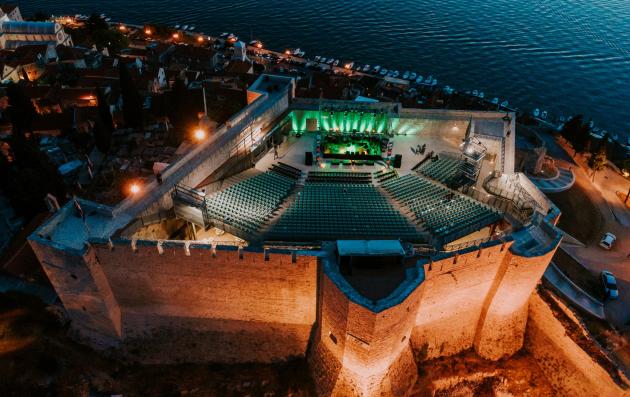Date of label : 29/10/2024
-
Sibenik , Croatia
-
Size of city : 34.302 inhabitants

This image shows an aerial view of a historic fortress or castle that has been transformed into an outdoor concert or event venue.
Summary
Fortress of Culture Šibenik manages five restored landmark heritage sites, transforming them into vibrant cultural hubs that promote urban regeneration and local development. These sites attract local and international visitors, entrepreneurs and investors.
Fortress of Culture Šibenik is a public institution established by the city of Šibenik (HR) in 2016. Today, this institution sustainably manages three restored fortresses in Šibenik – St. Michael’s Fortress, Barone Fortress and St. John's Fortress – as well as the House of Arts Arsen and the Croatian Coral Centre on the island of Zlarin. It promotes Croatian and European culture, with a modern, sustainable approach to the management of cultural sites, programming, heritage research and interpretation, community involvement, and education. Fortress of Culture Šibenik has therefore become nationally and internationally important in the cultural and creative sectors.
The solutions offered by the Good Practice
By integrating heritage preservation, economic growth, social engagement and sustainability, Fortress of Culture Šibenik supports the city's development strategy. By establishing a separate entity to manage cultural heritage sites, they city overcame the capacity and programming limitations encountered while managing in-house. Its management model is widely recognised, earning numerous national and European awards.
- St. Michael’s Fortress; a cultural attraction with a unique open-air summer stage on the Adriatic coast.
- Barone Fortress; a boutique location with the most beautiful view of the Šibenik city and its surroundings.
- St. John’s Fortress; the largest of the three, with an educational center for cultural and creative industries in its womb.
- House of Arts Arsen; a mixed-art venue- a house for all arts.
Croatian Coral Centre Zlarin; a cultural centre dedicated to reviving and preserving the history of a small island community.
Together, these five sites enhance quality of life in local community, extend the tourist season, and position Šibenik as a major cultural tourism centre in Dalmatia.
Building on the sustainable and integrated urban approach
Fortress of Culture Šibenik offers an integrated model for sustainable cultural development. This boosts the local economy with visitor attractions, supports local businesses, and fosters community participation through the Friends Club.
The comprehensive approach engages local people in cultural activities and decision-making processes, and promotes projects and events that raise awareness of environmental protection with a focus on recycling and waste reduction. By simultaneously addressing sustainability, economic growth and social inclusivity, the institution creates lasting benefits for both the community and the environment.
Based on a participatory approach
The participatory approach to managing Šibenik’s fortresses was established from the outset. Fortress of Culture Šibenik’s Management Board includes five members, who represent the city, a local NGO and the institution. Its entire work is dedicated to increasing participation in the community, for example, through various cultural educational programmes, research, and collaborations at the European level.
Partnerships with schools and universities have led to a series of educational programmes, while the Friends Club projects strengthen the cultural sector. The House of Arts Arsen is an excellent example of this participatory approach, involving local cultural NGOs at all stages to shape cultural content.
What difference has it made?
The cultural institution’s impact on the local community is clearly visible:
- Revitalising cultural sites: Restored heritage sites have become year-round community-focused vibrant hubs, attracting artists, creatives and international visitors. Local involvement is facilitated through the Friends Club, which provides accessible activities, free entry to sites, and an avenue for feedback through visitor surveys.
- Events: The institution organises around 550 cultural events annually, with more than 250 000 visitors to the five sites, including music, film, dance, theatre, and fine arts events. This has boosted the local cultural and creative sectors, and encouraged entrepreneurship in diverse cultural fields.
- Cultural tourism: By placing art, culture and heritage at the centre of urban renewal, cultural tourism has opened opportunities for local small and medium-sized companies to develop, including hotels, shops, local restaurants, and local food and drink producers.
- Jobs: The revitalised heritage and culture sites have created employment. The institution, for instance, has grown from eight employees in 2014 to 68 today.
Why this Good Practice should be transferred to other cities
Fortress of Culture Šibenik aligns with key policy initiatives:
- Sustainable Development Goals: SDG 4 (Quality education), SDG 11 (Sustainable cities and communities), SDG 12 (Responsible consumption and production).
- The Urban Agenda for the EU, by increasing resilience, strengthening local identity, economic growth, community cohesion and social inclusion, and the New European Agenda for Culture.
- Croatia's national governance and legislative framework, particularly regarding the protection of cultural property.
In 2021, Fortress of Culture Šibenik was included in the EU Cultural Heritage in Action programme. The institution hosted a learning visit for EU colleagues, and an exchange programme for Ukrainian cultural and heritage professionals as an act of solidarity.
Other cities across Europe looking for solutions on how to restore, protect, re-use and promote their heritage would benefit from transferring the model. It is a less common approach, as cities usually manage cultural heritage themselves which often results in reduced capacity and performance. By adapting elements like legal frameworks, funding, programming, and community participation to their own cities, this model can be implemented to enhance cultural revitalisation and community engagement.
